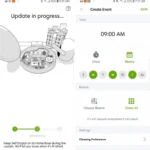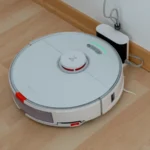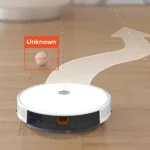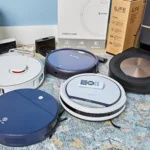In today’s fast-paced world, few people have the time or desire to engage in time-consuming household chores. This is where the convenience of vacuum cleaners comes in. Traditional vacuums have been around for decades and have always been known for their effectiveness in cleaning floors. However, with the recent rise of robot vacuums, many people are now wondering whether they should ditch their traditional vacuum cleaners and opt for the newer technology. But what exactly sets these two types of vacuums apart? In this article, we will compare the maintenance requirements of traditional and robot vacuums and help you decide which one might be a better fit for your lifestyle.
How Traditional Vacuums Work

Traditional vacuums have been a staple in households for many years, and they work by using suction to pull dirt and debris off floors and surfaces. However, the maintenance required for traditional vacuums can be a burden for some homeowners. Understanding how traditional vacuums work and their maintenance requirements is crucial to creating a cleaner home. So, let’s dive in and explore the mechanisms of traditional vacuums and why they require more maintenance compared to robot vacuums. For tips on robot vacuum maintenance and comparisons between traditional and robot vacuums, check out this helpful article.
Their Mechanism
Traditional vacuums have been used for decades and have a simple mechanism that has to be maintained frequently to guarantee their efficiency. Their mechanism includes a powerful motor that generates suction to pick up dirt and debris from the floors. The motor operates mechanical parts like belts and brushes that work together to whisk dirt off the surfaces. In most cases, the mechanical parts of traditional vacuums are powered by electricity, and this makes them heavy and hard to maneuver.
One of the most significant problems with the traditional vacuum mechanism is that the belts and brushes tend to get entangled with pet hair or human hair. When the belts and brushes get clogged, they may not function correctly, and this might lead to the vacuum’s breakdown. Frequently cleaning and replacing the belts and brushes is crucial to maintain the vacuum’s suction power and prevent costly repairs.
The traditional vacuum mechanism requires manual operation, which makes it tiring to clean an entire house. It requires the operator to push the vacuum cleaner back and forth to pick up dirt manually. This can cause pain in the back and arms, especially when using a heavy device. The traditional vacuums also require a backup bag collection system to store the dirt and debris picked up from the floors. The bags need to be frequently emptied, and sometimes individuals might not dispose of them properly, leading to air pollution.
Despite the heavy-duty mechanism that traditional vacuums have, they require frequent maintenance, which can be time-consuming and expensive. Maintaining traditional vacuums involves emptying the bags, cleaning or replacing the filters, removing clogs from the hoses and brush mechanisms, and replacing any worn-out parts. This regular upkeep can be overwhelming, given that traditional vacuums require maintenance after every use.
In comparison, robot vacuums operate on a simple but efficient mechanism that requires minimal maintenance. They come with an automatic program that enables them to clean the floors on their own. This eliminates the need for manual operation, thus reducing the risk of arm and back pains. The robot vacuums have suction systems, brushes, and sensors that allow them to navigate through the floors efficiently.
To keep robot vacuums in tip-top condition, they require a periodic clean up to remove any clogs in the brushes and sensors. They also feature self-cleaning mechanisms that minimize the need for frequent filter replacement. Maintenance of robot vacuums is less demanding, and they last longer than traditional vacuums.
Maintaining a robot vacuum is less of a hassle compared to traditional vacuums, and they guarantee an effortless, efficient, and convenient cleaning experience.
Their Bag Collection System
The bag collection system is an important part of traditional vacuums that contributes to their high maintenance. This system uses disposable bags made of paper, cloth or synthetic materials, where dust and debris are collected. The bag is attached to the hose of the vacuum cleaner, which creates a negative pressure that sucks in air and everything else in its path. As the dirty air flows through the bag, the debris gets trapped in the bag, and the clean air is released back into the environment.
Their Bag Collection System – An Overview
Traditional vacuums require bags to collect dust and debris, something which many people find to be time-consuming and $$$expensive$$$. To understand why, let’s take a closer look at the components of the bag collection system:
| Component | Details |
|---|---|
| The Bag | Disposable bags made of paper, cloth or synthetic materials, collect dust and debris. |
| The Hose | The hose of the vacuum cleaner attaches to the bag and creates a negatively pressurized flow of air. |
| The Debris Filter | Filters out larger particles to prevent them from entering the bag. |
Their Bag Collection System – Reasons for High Maintenance
Traditional vacuum cleaners with bag collection systems require constant maintenance because the bag needs to be replaced regularly. Over time, the bag becomes full of dust and debris, which limits the suction power of the appliance. A full bag also reduces the effectiveness of the filter system and can cause the vacuum to overheat. Ultimately, these problems can cause the motor to burn out, rendering the vacuum useless.
In contrast to traditional vacuums, robot vacuums have a dustbin collection system that requires less frequent maintenance. This is because the dustbin can be easily emptied, washed, and reused, without the need for expensive replacement bags.
If you’re interested in learning more about the benefits of robot vacuum maintenance and how to clean and maintain filters, we highly recommend reading our articles on the importance of robot vacuum maintenance and how to clean and maintain filters on a robot vacuum. Additionally, click here to discover the benefits of owning a robot vacuum, and here are some simple robot vacuum maintenance fixes you can do at home.
Their Filter System
Traditional vacuums rely on a filter system to trap dust, dirt, and other particles. The filter system consists of different types of filters that need to be regularly maintained to ensure the vacuum operates effectively. The following are some of the filters commonly used in traditional vacuums:
- Pre-Filter: The pre-filter traps larger dirt particles, hair, and debris before they reach the main filter. This filter prevents the main filter from getting clogged, which would reduce the vacuum’s suction power.
- HEPA Filter: High-Efficiency Particulate Air (HEPA) filters are designed to trap tiny particles that can cause allergies and other health problems. These filters are commonly used in vacuums to improve air quality and provide a healthier living environment.
- Exhaust Filter: The exhaust filter traps any debris that may escape the main filter, preventing them from being released back into the air. This filter is crucial in ensuring the air circulated back into the room is clean.
The downside to traditional vacuums’ filter system is that they require frequent replacement or cleaning. Over time, the filters can become clogged, which reduces the vacuum’s suction power and reduces air quality. Additionally, different types of filters may require different cleaning methods, which can be time-consuming and complex.
Conversely, robot vacuums have a simpler filter system that is easy to maintain. They typically use a small filter that is easily accessible and can be removed, cleaned, or replaced with minimal effort. This simplicity in the robot vacuum filter system is a significant advantage over the traditional vacuum system.
Why Traditional Vacuums Require More Maintenance
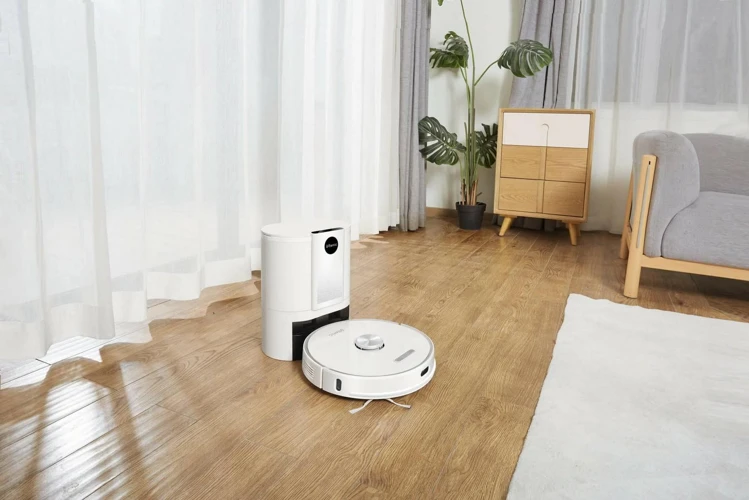
Maintaining traditional vacuums can be a daunting task, as they require more upkeep than their advanced counterparts. From continual maintenance to frequent filter and bag replacements, there are a plethora of reasons why traditional vacuums need more attention. The mechanism, bag collection, and filter system of traditional vacuums all contribute to the heightened maintenance requirements. Let’s delve into these reasons and find out why traditional vacuums demand more of our time and effort.
They Need Continual Maintenance
Traditional vacuums require a lot of maintenance to keep them working effectively. Here are some specific reasons why they need continual maintenance:
- Abrasive debris wear out brushes and belts: The constant friction of traditional vacuums’ brushes and belts against carpet fibers and other debris results in rapid wear and tear. This means that you will need to replace these parts regularly to keep the vacuum working properly.
- Clogs are common: Traditional vacuums are prone to clogging, which can reduce their suction power or even cause them to stop working altogether. You’ll need to unclog the vacuum frequently to prevent this from happening.
- Filters quickly become dirty: Traditional vacuums rely on filters to trap dirt and allergens. However, the constant use of the vacuum means that these filters quickly become dirty and clogged, reducing the vacuum’s suction power. You will need to replace or clean these filters at regular intervals to ensure the vacuum continues to work effectively.
- Dust and dirt accumulate: As you use a traditional vacuum, dust and dirt particles accumulate inside the machine. This can lead to unpleasant odors and can even affect your indoor air quality. To prevent this, you’ll need to clean out the vacuum regularly to remove any built-up dirt and debris.
All of these factors mean that traditional vacuums require a lot of time and effort to maintain. Regular cleaning, filter replacement, and part replacement can quickly become a major chore. Additionally, the cost of replacing parts and filters can add up over time. All things considered, a traditional vacuum may not be the most cost-effective option for many homeowners.
They Require Filter and Bag Replacement
One of the reasons why traditional vacuums require a lot of maintenance is due to the need for filter and bag replacement. This is particularly important in maintaining the efficiency and cleaning power of the vacuum over time. Here are the reasons why:
| Reasons | Description |
|---|---|
| Filtration System | The filtration system in traditional vacuums is designed to capture dirt, dust, and other debris; preventing them from blowing back into the air. Over time, the filter becomes clogged with dirt and dust, decreasing performance and increasing the strain on the motor. |
| Bag Collection System | The bag collection system in traditional vacuums is designed to capture and contain the dirt, dust, and other debris before it reaches the filter. The bag needs to be replaced when it becomes full or risk losing suction power. This can be a hassle to most people as they will need to constantly check their vacuum bag and replace it when necessary. |
| More Maintenance Required | Having to replace both the filter and bag can be a lot of work and can make vacuuming a chore. Failure to replace the filter and bag when required would lead to reduced suction power and loss of performance which could require expensive repairs for the vacuum. |
As traditional vacuums require continual filter and bag replacement, it can be quite frustrating and time-consuming. Robot vacuums, on the other hand, have a self-cleaning system that requires less maintenance, making them more convenient for those who do not have the time or inclination to do house chores often.
They Require Time-Consuming Maintenance
One of the biggest downsides to traditional vacuums is the amount of time-consuming maintenance they require. Let’s take a closer look at some of the most time-consuming maintenance tasks:
| Maintenance Task | Description | Frequency |
|---|---|---|
| Filter Cleaning/Replacement | Filters in traditional vacuums can get clogged with dirt and dust, reducing suction power. They need to be cleaned or replaced often to maintain optimal performance. | Every 3-6 months |
| Bag Replacement | Many traditional vacuums come with bags that need to be replaced after they fill up. This can be an annoying and time-consuming task. | Every 1-2 months |
| Brush Roll Maintenance | The brush roll in traditional vacuums can easily get tangled with hair and debris, which can hinder cleaning efficiency. It needs to be regularly cleaned or replaced. | Every 3-6 months |
| Belt Replacement | The belt in traditional vacuums is responsible for turning the brush roll. Over time, it can wear out or snap, and needs to be replaced to ensure the vacuum works properly. | Every 6-12 months |
As you can see, the maintenance tasks for traditional vacuums can really add up and take a lot of time. In contrast, robot vacuums require much less maintenance, which we will explore in the next section.
How Robot Vacuums Work
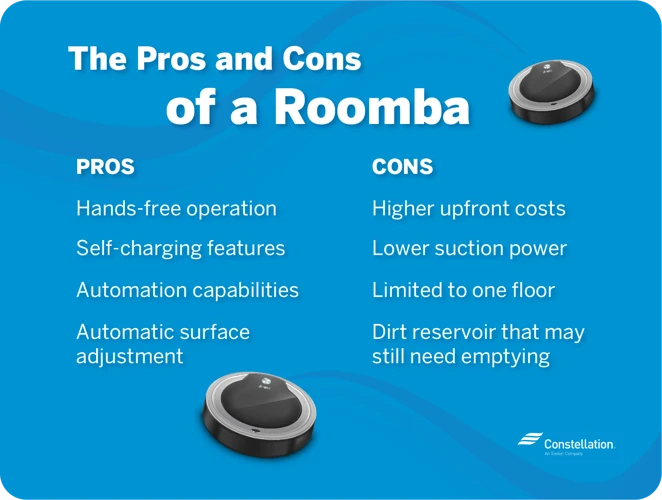
Have you ever wondered how those little round robots seamlessly glide around your home, picking up dirt and debris? With their sleek, compact design and advanced technology, robot vacuums are becoming increasingly popular among homeowners. But how do these machines work? Let’s explore the inner workings of robot vacuums and discover the mechanisms behind their efficient cleaning.
Their Sensors and Navigation
Robot vacuums use advanced technology that enables them to navigate your home while avoiding obstacles and cleaning your floors efficiently. These machines are equipped with sensors and navigation systems that allow them to move around the house without running into walls, furniture, or other obstacles.
Sensors
Robot vacuums are equipped with various sensors that help them navigate your home. These sensors include:
| Sensor Type | Description |
|---|---|
| Optical sensors | These sensors use infrared technology to detect objects in the vacuum’s path, allowing it to avoid obstacles and move around objects. |
| Bumper sensors | These sensors are located on the front of the vacuum and detect when the vacuum bumps into something. This allows the vacuum to change direction and continue cleaning. |
| Edge sensors | These sensors detect the edges of stairs, ledges or other drop-offs, allowing the vacuum to avoid falling off and potentially getting damaged. |
| Cliff sensors | These sensors can detect changes in floor height allowing the robot vacuum to avoid falling down stairs or ledges. |
Navigation
Robot vacuums use different methods for navigating your home. These methods include:
| Navigation Type | Description |
|---|---|
| Random navigation | Robot vacuums with random navigation move around your home randomly, cleaning as they go. They will eventually cover your entire floor space but may miss some spots. |
| Mapping navigation | Robot vacuums with mapping navigation use lasers, cameras or other advanced sensors to create a map of your home. This allows them to create an efficient cleaning path and avoid cleaning the same spot twice. |
| Virtual walls and barriers | Some robot vacuums come with virtual walls and barriers, which are magnetic strips that you can place around your home to keep the vacuum from entering certain areas. |
These advanced sensors and navigation systems allow robot vacuums to clean your home more efficiently and effectively than traditional vacuums. They navigate around objects with ease and clean every inch of your floor space. Additionally, these devices are programmable with timers and remote controls that make it easy to schedule cleaning times, set boundaries, or switch cleaning modes. The sensory and navigation systems in robot vacuums make them a great alternative for homeowners who seek more convenience and improved cleaning.
Their Brush System
Robot vacuums have a unique brush system that sets them apart from the traditional ones. The brush system is one of the most essential components of a robot vacuum cleaner, which ensures thorough cleaning of floors without the need for human intervention.
The brush system of robot vacuums usually consists of two main parts: the main brush and the side brushes. The main brush is responsible for cleaning the larger debris from the floor, while the side brushes are used to sweep the dirt and dust from corners and edges.
The brushes themselves are much different from the traditional vacuum brushes. They are usually made of silicone or rubber, which is gentle on floors and prevents damage. The bristles are also designed in such a way as to avoid getting tangled with hair and other similar debris.
To ensure that the brush system works efficiently, many robot vacuums come equipped with sensors that detect when the brushes need to be cleaned or replaced. This makes it very easy for users to maintain their robot vacuums and keep them working optimally.
Another advantage of the brush system of robot vacuums is that they can clean multiple floor types without any issues. Whether you have hardwood floors or carpets, the brushes will adjust accordingly to clean thoroughly without damaging the surfaces.
In comparison, traditional vacuums often have only one brush that rotates and picks up debris. This brush system can be too aggressive on certain floors and can cause damage over time. Additionally, traditional vacuums often require frequent brush replacement, which can be a hassle and also increase maintenance costs.
The brush system of robot vacuums is designed to provide efficient and thorough cleaning without causing any damage to floors. It is a significant reason why robot vacuums require less maintenance and, ultimately, less effort from the user.
| Traditional Vacuums | Robot Vacuums |
|---|---|
| Single rotating brush | Main brush and side brushes |
| Cannot clean all floor types | Can clean multiple floor types |
| Requires frequent brush replacement | Brushes are self-cleaning or require less frequent replacement |
| Can be too aggressive on floors | Gentle on floors with silicone or rubber brushes |
Their Dustbin System
Robot vacuums have a unique dustbin system that makes them low-maintenance compared to traditional vacuums. The dustbins are designed to store the dust and debris picked up during cleaning sessions.
Their Design: The dustbin on robot vacuums is usually compact and located underneath the device. It is made of sturdy materials and has a lid that holds the dust and debris tightly in place.
Easy Emptying: Once the dustbin is full, the user can easily empty the contents into a trash can. Most robot vacuums have a one-click release button which opens the lid of the dustbin, allowing the contents to empty quickly and efficiently.
Large Capacity: Although the dustbins on robot vacuums are typically smaller than those on traditional vacuums, they are still large enough to hold a substantial amount of dust and debris. Depending on the brand and model, some robot vacuums can go multiple cleaning sessions without having to be emptied.
No Mess: When emptying a dustbin on a traditional vacuum, there is always the risk of dust and debris flying out and making a mess. On the other hand, robot vacuums have designed their dustbin system to prevent this issue. The lid on the dustbin usually has a rubber seal that prevents any debris from escaping during emptying.
Robot vacuums have a highly efficient dustbin system that makes maintenance and cleaning easy and hassle-free.
Why Robot Vacuums Require Less Maintenance
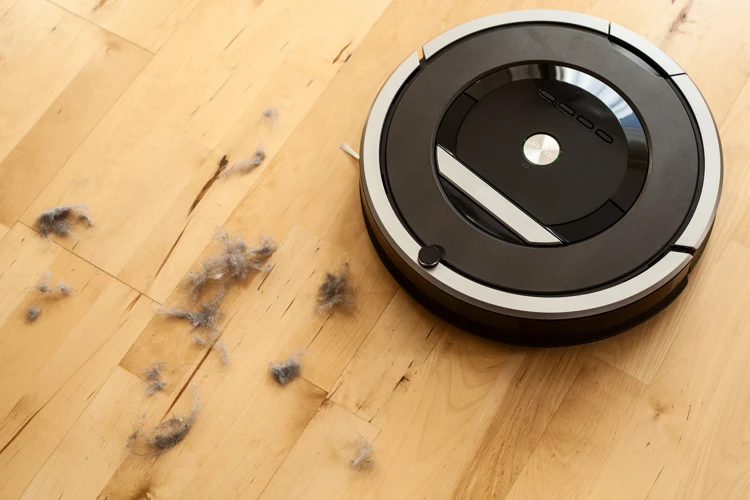
Maintaining cleanliness in your home is an ongoing task, and having a vacuum that requires meticulous and frequent maintenance can add to the stress. Fortunately, with advances in technology, the advent of robot vacuums has revolutionized the way we clean our homes. Robot vacuums are designed to make our lives easier and cleaning simpler. Not only are they efficient in cleaning, but they also require less maintenance compared to traditional vacuums. In this section, we’ll explore the reasons why robot vacuums require less maintenance, and how this makes them an ideal choice for busy households.
They Have Self-Cleaning Systems
Robot vacuums have a number of features that make them easier to maintain than traditional vacuums. One of the most important features is their self-cleaning systems, which free the user from having to manually clean the brush and filter after every use.
These systems work in different ways depending on the vacuum model, but they all share the purpose of keeping the vacuum clean, extending its lifespan, and ensuring it works efficiently without the need for extra maintenance.
Self-Cleaning Brush System: Robot vacuums have rotating brushes that pick up dirt and debris from carpets and floors. Over time, these brushes can become clogged with hair, dust, and other small particles, which can impact the vacuum’s performance. In contrast, robot vacuums are equipped with self-cleaning brush systems that use specialized combs to remove tangled hair and debris from the brushes automatically. This prevents the brushes from getting clogged, so the vacuum can keep picking up dirt and debris effectively.
Self-Cleaning Filter: Robot vacuums also have self-cleaning filters that capture dirt and debris as it vacuums. These filters can become clogged over time, reducing the vacuum’s suction power and making it less effective in cleaning. Fortunately, robot vacuums come equipped with self-cleaning filter systems as well, which use vibration or powerful suction to remove dirt from the filter. Some robot vacuums even come with high-efficiency particulate air (HEPA) filters that trap small allergens, bacteria, and dust particles.
Automatic Charging and Emptying: Robot vacuums are designed to be as hands-free as possible, so they can recharge and empty themselves without the need for human intervention. Some robot vacuums can detect when their battery gets low and return to their charging dock automatically. Similarly, some robot vacuums have a self-emptying function that allows them to empty their dustbins into a larger bin, so the user doesn’t have to do it manually.
The self-cleaning systems of robot vacuums make them a more convenient option for those who want to spend less time on vacuum maintenance. With less frequent maintenance needs, users can focus on other household chores or activities, and let their robots do the cleaning for them.
They Don’t Require Frequent Filter Replacement
One of the advantages of robot vacuums over traditional vacuums is that they require less frequent filter replacement. This is because robot vacuums are equipped with advanced filtration systems that trap dust and debris without clogging up easily. Let’s take a closer look at how robot vacuums achieve this and how it compares to traditional vacuums.
Traditional vacuums usually have either a bag collection system or a filter system to capture dirt and debris. These bags and filters require frequent replacement, especially for households with pets or allergies. Most vacuum manufacturers suggest replacing the bags or filters every two to three months for optimal performance.
On the other hand, robot vacuums have a multi-stage filtration system that includes a primary filter and sometimes a high-efficiency particulate air (HEPA) filter. These filters capture microscopic particles that are harmful to allergy sufferers and can cause respiratory problems. The filters in robot vacuums don’t need frequent replacement, and some models even have self-cleaning capabilities.
Here’s a comparison table that summarizes the filter replacement needs of traditional vacuums and robot vacuums:
| Traditional Vacuums | Robot Vacuums | |
|---|---|---|
| Filter Replacement Frequency | Every 2-3 months | Less frequent |
| Advanced Filtration | No, unless it has HEPA filter | Yes, multi-stage filtration with HEPA filter |
| Self-Cleaning | No | Some models have self-cleaning capabilities |
As you can see, robot vacuums are far less demanding when it comes to filter replacement needs. This means less time and money spent on maintenance, and more time for you to enjoy a clean home.
They Are Easy to Clean and Maintain
Robot vacuums are a popular choice among homeowners due to their convenience and ease of use. One of the main advantages of robot vacuums over traditional vacuums is that they are incredibly easy to clean and maintain. Here are some reasons why:
1. Minimal Maintenance: Robot vacuums require minimal maintenance, making them a hassle-free option for busy individuals. Unlike traditional vacuums, they don’t need to be cleaned after every use. In fact, most robot vacuums require only weekly or bi-weekly maintenance.
2. Easy to Clean: Robot vacuums are incredibly easy to clean. Most models come with detachable dustbins that can be easily removed, emptied, and cleaned. Some models even have self-emptying dustbins, which means that you don’t have to worry about emptying the dustbin at all. Additionally, most robot vacuums come with brushes that can be removed for easy cleaning.
3. Self-Cleaning Systems: Some robot vacuums come with self-cleaning systems that keep the robot vacuum in top condition. For instance, some models have a self-cleaning brushroll that removes tangled hair and debris. This helps to ensure that the vacuum is always running optimally, without any obstructions that could impact its performance.
4. Smart Maintenance Alerts: Many robot vacuums come with smart maintenance alerts that inform you when it’s time to clean or replace a particular component. This helps to ensure that you never miss any important maintenance tasks and that your vacuum is running smoothly at all times.
5. Long-Lasting Filters: Robot vacuums typically use high-quality filters that can last for months before needing to be replaced. This is in contrast to traditional vacuums that often require frequent filter replacements, adding to the overall maintenance cost.
All in all, robot vacuums are incredibly easy to clean and maintain. With minimal maintenance requirements and smart features like self-cleaning systems and maintenance alerts, keeping a robot vacuum in top condition is a breeze.
Comparison between Traditional and Robot Vacuums
As technology progresses, more and more household appliances are being automated for our convenience. One of the most significant examples of this automation is the evolution of vacuum cleaners from traditional ones to robotic ones. Both types of vacuums have their own unique set of benefits and drawbacks, making it difficult for consumers to decide which one to choose. Let’s delve into the comparison between traditional and robot vacuums, to help you understand and decide which is more suitable.
Pros of Traditional Vacuums
While traditional vacuums may require more maintenance compared to robot vacuums, they do have some advantages. Let’s take a look at some of the pros of traditional vacuums in detail in the table below:
| Pros of Traditional Vacuums |
|---|
| Powerful suction: Traditional vacuums are often more powerful than their robot counterparts as they usually have a much larger motor. They are capable of capturing larger debris and cleaning deeper into carpets and upholstery making them a better choice for heavy-duty cleaning. |
| Effective at removing pet hair: Traditional vacuums often come with specialized attachments designed specifically for removing pet hair. These attachments have powerful bristles and suction to capture and remove pet hair from furniture, carpets, and other surfaces effectively. |
| Easy to repair: Traditional vacuums are easier to repair compared to robot vacuums as their parts are easily accessible and can be replaced when necessary. Additionally, many manufacturers offer customer support and repair services, making it easy to keep your vacuum in top working condition. |
| Long lifespan: With proper maintenance and care, traditional vacuums have a longer lifespan compared to robot vacuums. You can expect to use your traditional vacuum for many years, making it a worthwhile investment in the long run. |
Traditional vacuums still have some distinct advantages over robot vacuums. While they may require more maintenance, their powerful suction, effective pet hair removal, ease of repair, and long lifespan make them a worthwhile choice for many households.
Cons of Traditional Vacuums
When it comes to traditional vacuums, there are several cons that cannot be ignored. Here are some of the biggest drawbacks:
| Cons of Traditional Vacuums |
|---|
| Require continual maintenance: Traditional vacuums need ongoing maintenance to keep them working properly, which can be time-consuming and frustrating for busy homeowners. |
| Require frequent filter and bag replacement: The filter and bag systems in traditional vacuums require regular replacement, which can be costly over time. |
| Time-consuming maintenance: Even routine vacuuming with a traditional model can be a chore, involving heavy lifting and maneuvering around furniture and other obstacles. |
| High noise levels: Traditional vacuums can be loud and disruptive, which can be especially problematic in small homes or apartments with thin walls. |
| Less efficient: Because traditional vacuums rely on manual operation, they may not pick up as much dirt, dust, and debris as newer models. |
While traditional vacuums are still widely used and effective, they do come with inherent downsides that robot vacuums seek to address in innovative and convenient ways.
Pros of Robot Vacuums
Robot vacuums are increasingly popular among homeowners and for a good reason. Here are some of the pros of using a robot vacuum:
- Convenience: One of the most significant advantages of robot vacuums is their convenience. They require minimal effort from the user and can clean floors without supervision. You can set them to clean at specific times or even on a schedule, ensuring your floors stay clean without any effort on your part.
- Time-saving: Robot vacuums can save you a lot of time. Instead of spending hours vacuuming your home, you can spend that time doing other important things. Robot vacuums can clean floors faster than traditional vacuums, allowing you to focus on other tasks.
- Intelligent: Robot vacuums are equipped with sensors and intelligent navigation systems that allow them to navigate around obstacles, climb over them or avoid them altogether. They can even detect areas that are dirtier and focus on cleaning them more thoroughly.
- Efficient: Robot vacuums are incredibly efficient at cleaning floors. They use powerful suction and a brush system to clean floors thoroughly, even in hard-to-reach areas.
- Low maintenance: Robot vacuums require minimal maintenance compared to traditional vacuums. They have self-cleaning systems that clean their brushes, and their dustbin can be emptied with ease. They also don’t require frequent filter replacement.
- Effective on different surfaces: Robot vacuums can clean different types of floors, including carpets, hardwood, and tile. They can also adjust their suction power and brush system to suit different floor surfaces.
Robot vacuums provide convenience, save time, are intelligent, efficient, low maintenance, and effective on different surfaces.
Cons of Robot Vacuums
While robot vacuums have certainly made our lives easier, they’re not without their drawbacks. Here are some cons of robot vacuums:
- Limited Cleaning Power: Robot vacuums are great for everyday cleaning but they may not have the same powerful suction as traditional vacuums, making them less effective on carpets or deep cleaning tasks.
- Navigation Challenges: While robot vacuums are designed to navigate their environment, they can still struggle in cluttered or irregularly shaped rooms. They may need some guidance and may not be as efficient as traditional vacuums in terms of cleaning speed.
- Expensive: Robot vacuums are more expensive than traditional vacuums, making them a significant investment for many households.
- Technology Limitations: Robot vacuums rely on sensors and programming and can have limitations in terms of functionality, which can reduce their effectiveness in certain situations. For example, they may struggle to clean stairs or handle certain types of debris.
- Regular Maintenance Required: While robot vacuums require less maintenance than traditional vacuums, they still need regular upkeep to ensure their sensors and brushes are clean and functioning properly.
Despite these cons, robot vacuums remain a popular choice for many households due to their convenience and time-saving features. However, it’s important to carefully consider your cleaning needs and lifestyle before making a purchase to ensure you’re making the right choice for your home.
Conclusion
After examining the differences between traditional vacuums and robot vacuums, it’s clear that both have their pros and cons. Traditional vacuums have strong suction power and are ideal for deep cleaning, but require frequent maintenance and upkeep to function at their best. Robot vacuums, on the other hand, are convenient and require little effort, but may not be as powerful and may miss spots.
Ultimately, the choice between a traditional or robot vacuum comes down to personal preference. If you are someone who enjoys hands-on cleaning and wants a vacuum with great suction power, a traditional model may be the way to go. However, if you have a busy lifestyle and want a hassle-free way to keep your floors clean, a robot vacuum can be a good investment.
It’s crucial to remember that when it comes to vacuums, one size does not fit all. Each type of vacuum has its unique features and advantages that can make cleaning easier, so it’s up to the user to choose what works best for their lifestyle.
In the end, the most important factor to consider is finding a vacuum that will keep your floors clean and maintained with the least amount of effort and time required from you. Whether you decide on a traditional or robot vacuum, make sure to research your options and choose a quality model that will last for years to come.
Frequently Asked Questions
Can traditional vacuums clean corners and tight spaces effectively?
While traditional vacuums may struggle with corners and tight spaces, they often have attachments or crevice tools specifically designed for those areas.
Do robot vacuums work on all types of flooring?
Most robot vacuums are designed to work on a variety of flooring types, including carpet, hardwood, and tile.
Can traditional vacuums pick up pet hair?
Yes, traditional vacuums can pick up pet hair, but it may require frequent maintenance, including cleaning or replacing filters and bags.
Are robot vacuums loud?
Robot vacuums are generally quieter than traditional vacuums, although the level of noise may vary depending on the brand and model.
Do traditional vacuums have HEPA filters?
Some traditional vacuums have HEPA filters, but not all. HEPA filters are designed to capture small particles, such as dust and allergens.
Can robot vacuums navigate stairs?
No, robot vacuums are not designed to navigate stairs and can be dangerous if they accidentally fall off a stairs.
Do robot vacuums require Wi-Fi or internet access?
Some advanced robot vacuums require Wi-Fi or internet access to work with the compatible app and for software and firmware updates.
Do traditional vacuums have a self-charging feature?
No, traditional vacuums do not have a self-charging feature as they rely on a power outlet to function.
Can robot vacuums replace traditional vacuums completely?
While robot vacuums are convenient and require less maintenance, they may not be as effective as traditional vacuums in cleaning certain areas or deep-cleaning carpets.
What is the average lifespan of a robot vacuum?
The average lifespan of a robot vacuum can vary, but it is typically between 3 to 5 years with proper maintenance and care.

